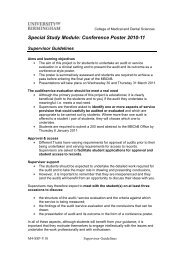Contents - College of Medical and Dental Sciences - University of ...
Contents - College of Medical and Dental Sciences - University of ...
Contents - College of Medical and Dental Sciences - University of ...
Create successful ePaper yourself
Turn your PDF publications into a flip-book with our unique Google optimized e-Paper software.
The 11 th International Workshop on KSHV & Related Agents, Birmingham, UK<br />
Pathogenesis Abstract 16<br />
DEVELOPMENT OF ANIMAL MODELS OF KSHV INFECTION AND AIDS-<br />
ASSOCIATED DISEASE BASED ON MACAQUE RHADINOVIRUSES<br />
A. Gregory Bruce 1 , Jonathan T. Ryan 1 , Courtney Gravett 1,2 , <strong>and</strong> Timothy M. Rose 1,2 ,<br />
1 Seattle Children’s Hospital Research Institute <strong>and</strong> 2 <strong>University</strong> <strong>of</strong> Washington, Seattle WA<br />
Abstract<br />
Two related viral lineages within the Rhadinovirus genus <strong>of</strong> gammaherpesviruses have<br />
been identified in macaques <strong>and</strong> other Old World non-human primates. In macaques,<br />
the prototypes <strong>of</strong> these lineages were first identified in the rhesus macaque (Macaca<br />
mulatta); retroperitoneal fibromatosis-associated herpesvirus (RFHVMm) <strong>and</strong> rhesus<br />
rhadinovirus (RRV) members <strong>of</strong> the Rhadinovirus-1 (RV1) <strong>and</strong> RV2 lineages, respectively.<br />
Each macaque species is host to a distinct pair <strong>of</strong> RV1 <strong>and</strong> RV2 rhadinoviruses,<br />
distinguishable by molecular sequence. Both RV1 <strong>and</strong> RV2 rhadinoviruses have been<br />
implicated in diseases in macaques that closely resemble cancers <strong>and</strong> proliferative<br />
diseases associated with KSHV in humans, including Kaposi sarcoma (KS), lymphoma<br />
<strong>and</strong> multicentric Castleman’s disease. Thus, the characterization <strong>of</strong> the macaque<br />
rhadinoviruses, including the development <strong>of</strong> specific reagents <strong>and</strong> assays that enable<br />
the evaluation <strong>of</strong> their biology <strong>and</strong> life cycles, is an important aspect in the development<br />
<strong>of</strong> KSHV-related macaque models <strong>of</strong> disease. We have developed protocols for<br />
experimental infection <strong>of</strong> macaques with both RV1 <strong>and</strong> RV2 macaque rhadinoviruses, <strong>and</strong><br />
are developing reagents <strong>and</strong> analytical approaches to follow the resulting infections <strong>and</strong><br />
host responses to infection in vivo. We will present the current status <strong>of</strong> the first small<br />
pilot study examining the experimental infection <strong>of</strong> naïve macaques with infectious<br />
rhadinoviruses from saliva <strong>of</strong> infected macaques <strong>and</strong> subsequent chemical <strong>and</strong> viral<br />
treatments to activate virus by inducing immunosuppression. These studies will provide<br />
the groundwork for establishing relevant animal models <strong>of</strong> human disease associated<br />
with KSHV.<br />
Presenting author Email: greg.bruce@seattlechildrens.org<br />
38















